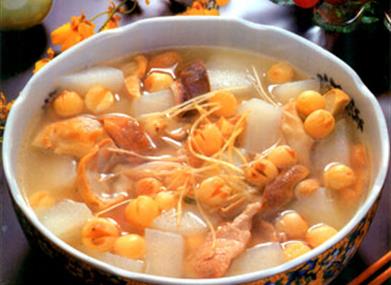

It’s not unusual for a patron to be brought a live fish or crab at the table as proof of the freshness of the In many restaurants, guests can choose their meal from a seafood tank in the dining room. As an honor to guests, freshness is one of the ultimate ‘ingredients’ in Cantonese regional cooking. Chinese courtesy demands that a guest be treated with honor, and to present a guest with anything less than perfection is the height of rudeness. In true Oriental fashion, a meal is poetry, with every part of it contributing to the overall effect.
Chinese cooking is a presentation of texture, color, shape and aroma with even the name of the dish contributing to its overall presentation. All Chinese cuisine takes far more into account than the flavor of a dish. For many who are used to the more rich, spicy and complex flavors of Hunan and Szechwan cooking, Cantonese cooking may seem bland – but the subtle blends of flavor and aroma are created by the hand of a master chef. The spices used in Cantonese cooking tend to be light and simple: ginger, salt, soy sauce, white pepper, spring onion and rice wine.
The light, delicate sauce, quick cooking and subtle spicing allows the natural flavors to shine through rather than being overwhelmed and blending together. Its proximity to the sea offers a veritable marine cornucopia to be added to its dishes, making possible such delicate mating as Seven Happiness, a dish that includes shrimp, scallops, fish and lobster along with chicken, beef and pork. Of all the Chinese regions, Canton (Guangdong province) has the most available food resources. Simple spices and a wide variety of foods used in cooking characterize Cantonese cuisine.
Easily the most well-known of the Chinese regional cuisines, Cantonese cuisine comes from the region around Canton in Southern China.
Chinese cooking is a presentation of texture, color, shape and aroma with even the name of the dish contributing to its overall presentation. All Chinese cuisine takes far more into account than the flavor of a dish. For many who are used to the more rich, spicy and complex flavors of Hunan and Szechwan cooking, Cantonese cooking may seem bland – but the subtle blends of flavor and aroma are created by the hand of a master chef. The spices used in Cantonese cooking tend to be light and simple: ginger, salt, soy sauce, white pepper, spring onion and rice wine.
The light, delicate sauce, quick cooking and subtle spicing allows the natural flavors to shine through rather than being overwhelmed and blending together. Its proximity to the sea offers a veritable marine cornucopia to be added to its dishes, making possible such delicate mating as Seven Happiness, a dish that includes shrimp, scallops, fish and lobster along with chicken, beef and pork. Of all the Chinese regions, Canton (Guangdong province) has the most available food resources. Simple spices and a wide variety of foods used in cooking characterize Cantonese cuisine.
Easily the most well-known of the Chinese regional cuisines, Cantonese cuisine comes from the region around Canton in Southern China.